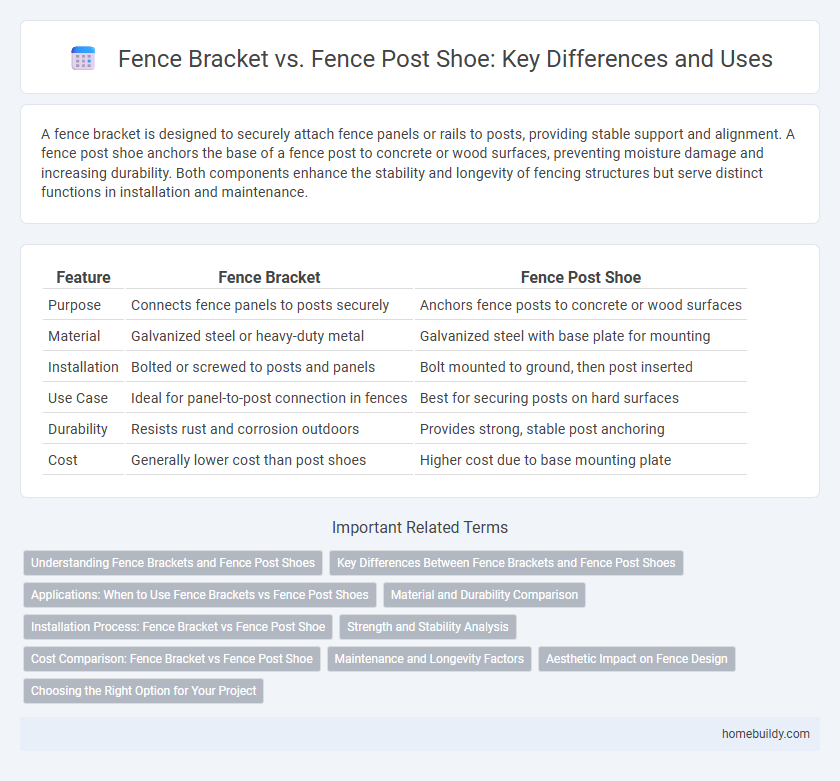A fence bracket is designed to securely attach fence panels or rails to posts, providing stable support and alignment. A fence post shoe anchors the base of a fence post to concrete or wood surfaces, preventing moisture damage and increasing durability. Both components enhance the stability and longevity of fencing structures but serve distinct functions in installation and maintenance.
Table of Comparison
| Feature | Fence Bracket | Fence Post Shoe |
|---|---|---|
| Purpose | Connects fence panels to posts securely | Anchors fence posts to concrete or wood surfaces |
| Material | Galvanized steel or heavy-duty metal | Galvanized steel with base plate for mounting |
| Installation | Bolted or screwed to posts and panels | Bolt mounted to ground, then post inserted |
| Use Case | Ideal for panel-to-post connection in fences | Best for securing posts on hard surfaces |
| Durability | Resists rust and corrosion outdoors | Provides strong, stable post anchoring |
| Cost | Generally lower cost than post shoes | Higher cost due to base mounting plate |
Understanding Fence Brackets and Fence Post Shoes
Fence brackets provide sturdy support by attaching fence rails directly to posts, ensuring a secure and stable framework. Fence post shoes, typically made of metal, anchor fence posts to concrete or wooden surfaces, preventing moisture damage and prolonging post life. Understanding the distinct roles of fence brackets and post shoes is crucial for selecting the right components to enhance fence durability and stability.
Key Differences Between Fence Brackets and Fence Post Shoes
Fence brackets are typically L-shaped metal supports designed to secure horizontal fence rails to posts, providing stability and ease of installation. Fence post shoes, on the other hand, are base-mounted metal brackets that anchor fence posts to concrete or wooden surfaces, preventing direct wood-to-ground contact and reducing rot. Key differences include their placement--brackets connect rails to posts, while post shoes secure posts to foundations--and their role in prolonging fence durability and alignment.
Applications: When to Use Fence Brackets vs Fence Post Shoes
Fence brackets are ideal for attaching fence rails directly to wooden posts, providing sturdy support in traditional wooden fencing applications. Fence post shoes serve as a metal base anchoring fence posts to concrete surfaces, preventing wood-to-ground contact and increasing durability in installations on patios or decks. Use fence brackets for wood-on-wood connections and fence post shoes when securing posts to masonry or concrete substrates.
Material and Durability Comparison
Fence brackets are typically made from galvanized steel or heavy-duty aluminum, offering strong resistance to rust and corrosion for long-lasting structural support. Fence post shoes, often constructed from thicker steel with a powder-coated finish, provide enhanced durability against weather exposure and physical impacts. The choice of material directly impacts the longevity and maintenance requirements, with steel post shoes generally outperforming brackets in harsh outdoor environments.
Installation Process: Fence Bracket vs Fence Post Shoe
Fence brackets install quickly by attaching directly to existing surfaces using screws or bolts, requiring minimal preparation and reducing labor time. Fence post shoes involve setting the post into a metal bracket anchored with concrete, ensuring greater stability but demanding more extensive groundwork and curing time. Choosing between the two depends on project scope, load requirements, and installation complexity preferences.
Strength and Stability Analysis
Fence brackets provide enhanced strength and stability by securely anchoring fence panels to posts using multiple fastening points, distributing load evenly and reducing stress on individual components. Fence post shoes primarily offer base protection against moisture and corrosion but may lack the structural reinforcement that brackets provide for lateral forces and heavy loads. In applications demanding robust fence integrity under dynamic conditions, fence brackets outperform post shoes by maintaining fence alignment and preventing wobbling or sagging over time.
Cost Comparison: Fence Bracket vs Fence Post Shoe
Fence brackets generally offer a more cost-effective solution compared to fence post shoes, with prices often 20-30% lower due to simpler designs and less material usage. Fence post shoes, while pricier, provide enhanced stability and corrosion resistance, justifying their higher installation and maintenance costs over time. Choosing between these options depends on budget constraints and the desired longevity of fence support structures.
Maintenance and Longevity Factors
Fence brackets require less maintenance compared to fence post shoes due to their simpler design, which reduces the risk of rust and structural wear over time. Fence brackets often utilize galvanized steel or powder-coated finishes, enhancing corrosion resistance and extending the fence's lifespan. In contrast, fence post shoes, while providing strong anchoring, may trap moisture, increasing the need for regular inspection and upkeep to prevent deterioration.
Aesthetic Impact on Fence Design
Fence brackets provide a sleek, minimalistic attachment point that enhances the clean lines of modern fence designs, creating a visually appealing and unobtrusive look. In contrast, fence post shoes are bulkier and more visible, often interrupting the fence's aesthetic flow with their utilitarian appearance. Choosing fence brackets can elevate the overall design by maintaining an elegant and seamless connection between posts and rails.
Choosing the Right Option for Your Project
Fence brackets and fence post shoes serve distinct purposes in securing fence posts, with brackets typically used for attaching horizontal rails to posts, offering stability and alignment. Fence post shoes provide a base that protects the post from ground moisture and corrosion, enhancing longevity by elevating it above soil or concrete. Selecting the right option depends on the project's structural needs and environmental conditions, with brackets ideal for rail connections and post shoes essential for prolonged durability in outdoor installations.
Fence bracket vs Fence post shoe Infographic

 homebuildy.com
homebuildy.com